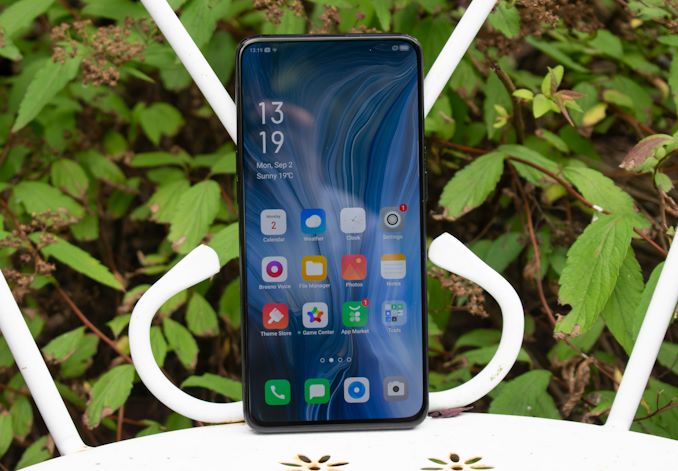The Snapdragon 855 Phone Roundup: Searching for the Best Implementations
by Andrei Frumusanu on September 5, 2019 8:30 AM ESTTop Devices - China & Gaming Contenders
Aside from the well-known phones in western markets, we’ve seen Chinese vendors have quite large success in European and other global markets. These devices are less prevalent in the US, however they can offer some unique value and differentiating experiences compares to the usual brands.
Xiaomi Mi9
Xiaomi Mi9 family of phones were among the first Snapdragon 855 devices to be released, hitting the streets at the same time as Samsung’s S10 series. Xiaomi in particular seems to be a leading vendor cooperating very closely with Qualcomm in defining the experience of their devices.
What stands out for the Mi9 is that when it was released, it came at an incredible price-point of only 449€, vastly undercutting other offerings with the high-end Snapdragon 855. Today the Mi9 can be had for as little as 376€, which remains one of our top picks at this price point.
The Mi9 is on the smaller side when it comes to form-factors, and it’s the smallest device amongst today’s roundup, even though by any means it can still be considered a big phone by traditional standards. The build quality of the phone stands out – it’s a very solid yet lightweight device that punches far above its weight and price. Xiaomi still employs a triple-camera setup which puts it on par with other flagship devices this year. The camera quality also manages to easily compete with that of other devices such as the OnePlus 7 Pro – not a big surprise as it’s among the many devices this year using the popular IMX586 camera sensor. In fact, all devices on this page use the same sensor.
Compromises for the Mi9 fall in aspects such as only having a mono-speaker and its battery life being only about average – two well worth compromises for an otherwise incredibly attractive price-to-performance package.
Full review to follow in the next weeks.
OPPO Reno 10x Zoom
OPPO’s main focused for the last several years has been the Chinese market where they’re incredibly successful in, being one of the top smartphone vendors there. Recently, OPPO has decided to enter western market and this year has launched its flagship device sin various markets in Europe. The OPPO Reno series is marked as also having distinguished designs with bezel-less full-screen experiences. The display panel remains an OLED, but unlike the OP7Pro, this remains a 1080p 60Hz unit. We find a similar slide-out front-camera mechanism, just this time around it’s a wedge design instead of the rectangular slide-out on the OP7Pro.
Key characteristics of the OPPO Reno 10x zoom is basically spoiled by the device’s name: It has an augmented telephoto module capable of up to 10x hybrid zoom (6x optical) thanks to the sensor being laid out in a 90° angle and looking out the back of the phone thanks to a mirror prism. It’s the same kind of mechanism that Huawei used on the P30 Pro, but has the same issues of not being that particularly useful in everyday photography. The phone also employs wide-angle and ultra-wide-angle modules, and seemingly is actually able to provide a better image capture experience than say the OP7Pro, even though having the same or very similar sensors all whilst having the same SoC chipset for processing.
Full review to follow in the next weeks.
Xiaomi Black Shark 2
In the last year or two we’ve seen increased popularity in so called “gaming phones”. The design of these smartphones is straight out of the book of laptop manufacturers who offer specialized “gaming laptops” that are characterized by their unmistaken “gaming design accents” – for a lack of a better description.
Xiaomi last year with the original Black Shark was among the first to offer such phones, and this year we saw the follow-up with the Black Shark 2. The phone’s key differentiators here is that it’s offering a more “robust” design as well as a hardware switch that puts the phone in a dedicated gaming mode with a different software launcher optimized for a gaming experience, separating it from the more vanilla Android experience that the phones ship with.
Hardware wise, things are very similar to the Mi9 and the camera employs the same main sensor and telephoto lens as on its sibling device. Differences with the gaming design is that Xiaomi is employing dual front facing speakers.
The one aspect you’d expect gaming phones such as the Black Shark 2 to be optimized for is their thermal dissipation design, offering better SoC cooling and thus able to deliver long-term gaming performance. Unfortunately the Black Shark 2 didn’t fare very well in this regard and it’s among the weakest phones we’ve come to test when it comes to thermal stress performance.
Full review to follow in the next weeks.
ZTE Nubia RedMagic 3
Another device that can be strictly put in the category of “gaming phones” such as the Black Shark 2 is ZTE’s Nubia RedMagic 3. This might come out of the blue for most readers as many will have no heard of the device, however it offers some very interesting hardware features.
It offers a 1080p 90Hz screen which ticks off this aspect of a gaming phone. ZTE offers the same popular hardware switch on the phone which puts the device into a dedicated gaming mode with custom app launcher.
We’ll be covering the device in more detailed fashion in a dedicated review, but the most interesting aspect of the device is the fact that it has an actual fan in it. Yes you’re read that right, the phone actually has a small active cooling fan along with air intake and exhaust – something I definitely wanted to put through our GPU testing methodology to see if actually makes any difference and helps with prolonged gaming performance.
Full review to follow in the next weeks.














47 Comments
View All Comments
cha0z_ - Monday, September 9, 2019 - link
Actually the exynos is more EXPENSIVE! Note 9 when released costed 1100 euros in Europe vs 1000 dollars in US, you can check the conversion yourself as 1000 euros are over 1100 dollars. The fact you got a samsung device for cheaper is nothing exclusive to you nor China - there are super big discounts in US too for the qualcomm variants.s.yu - Monday, September 9, 2019 - link
Actually I look before I buy, the SK version is the cheapest anywhere, I had the option of buying the HK version(on SD) of the same tier for ~$100 more but I decided against it thinking it's not worth the premium.A friend in the US also bought a Note 8 at the time and went for an HK version because getting it from HK is still cheaper than in the US and he preferred SD. I don't know how there are significant discounts in the US but suspect they're bound by contracts.
As for the high price in Europe that should come as a surprise to no one. Most electronics are more expensive in Europe, it's not specific to Samsung.
1nterceptor - Tuesday, September 10, 2019 - link
I agree, would be really great if we could see exy9825 vs exy 9820 vs sd855+ vs sd855. Why exy9820 and sd855 you may ask, well because of the software updates, i wonder if and how much difference does it make now after 6 months on the market and couple of firmware updates...1nterceptor - Tuesday, September 10, 2019 - link
...although, i believe exy9825 is not by any means much faster/better than the "old" 9820, it is probbably more efficient on the other hand...jrocket - Thursday, September 5, 2019 - link
Since many of these phones vary in price significantly, it would be interesting to see a "performance per dollar" value comparison.IUU - Friday, September 6, 2019 - link
Would be if it was not so trivial. I mean , if one phone costs 400 dollars and another one 800, there you have straight away your performance per dollar. All are sd 855s , so there is nothing more to consider. One could argue about camera, screen, battery life, but these are irrelevant to performance.flyingpants265 - Tuesday, September 17, 2019 - link
It says right in the article that the performance differs depending on software implementation.Wardrive86 - Thursday, September 5, 2019 - link
Excellent article as always! I would like to see which version of Android each phone has in the system performance tests to see if some of the older device performance data is up to date and also see which Opengl and Vulkan drivers each device has while testing was done...however even without that data still the best tech site there is. Thanks!Wardrive86 - Sunday, September 8, 2019 - link
For example:LG G7 Android 9 opengl driver : 331.0
Slingshot Extreme Unlimited OpenGL ES 3.1
Physics peak : 3486
Physics sustained : 3392
Graphics peak : 5467
Graphics sustained: 5326
(5 runs, 20 minutes, Room temp: 78F/25.6C)
Immediately followed by Work 2.0
Performance : 8146
Web : 6588
Video : 5701
Writing. : 9554
Photo : 15830
Data : 6314
yacoub35 - Thursday, September 5, 2019 - link
Aside from battery life, the things I would care most about in a phone comparison are:Does it have stereo speakers?
Does it have a headphone jack?
Does it use vanilla Android (or how close to vanilla is what it uses)?
Does it get all of the Android updates and security patches in a timely fashion?
How is the camera performance (speed to load the app and take a photo, image stabilization, low light performance)?
How much RAM does it have?
How much internal storage (excluding the OS) and how much expandable, if any?